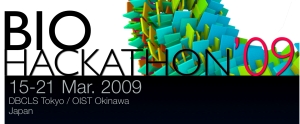Satellite meeting for Use-cases development and documentation
Topics
Several examples of the biological data are provided by users. The service developers explained how to use their programs for the data. Finally, users described the several potential work-flows for the computational part of their research.
Participants
- Toshiaki Katayama
- Young Joo Kim
- Keun-Joon Park
- Yunsun Nam
- Arek Kasprzyk
- Syed Haider
- Shuichi Kawashima
- Takeshi Kawashima
- Raoul JP Bonnal
- Tatsuya Nishizawa
- Oswaldo Trelles
- José M. Fernández
- Paul Gordon
- Vachiranee Limviphuvadh
- Tobias Gattermayer
- Riu Yamashita
- Fumikazu Konishi
- Takatomo Fujisawa
- Bruno Aranda
Targets
Date
- 2009/3/19 15:00-18:00
- anytime
Room
- 3F
Notes
Data for testing
- SNPs data contain 262,338 SNPs (Stroke patient vs. normal) from Affymetrix SNP Chip (provided by Prof.Kim)
- Amino acid sequences of 53 genes (multifasta format) which are located at disease map locus of one form of epilepsy (provided by Vachiranee)
- Nucleotide sequences (multifasta format) (provided by Riu)
- Genome data (provided by Takeshi)
Softwares
- BioMart
- Galaxy
- jORCA
- ANNOTATOR
Meeting log
Genome data
Question - Takeshi asked about how to annotate in-house data by comparing with public genome data using BioMart. - For example, how to annotate Halocynthia roretzi or Molgula tectiformis ESTs comparing with Ciona intestinalis and Ciona savigni using BioMart. Answer - Convert Halocynthia data into BioMart format. Install BioMart server locally. Then merge public DB and local data together. - BioMart format is simple.
Takeshi presented an example - minor animal (ex, H.roretzi, closest animal of Ciona) - how can analyze Halocynthia roretzi and M.tectiformis which are rare annotation. - type of data is ESTs, assembled EST cluster,etc - potential flow: BioMart -> ANNOTATOR -> TogoDB
SNPs data
ANNOTATOR currently can not analyse SNPs data itself but can analyze genes data which contain SNPs of interested.
Galaxy ( http://galaxyproject.org) and RGenetics ( http://rgenetics.org/)
quality control, ancestry, case-control analysis, tdt, oter statistical tests
-can link dbSNPs to Galaxy for further analysis
Multifasta format (amino acid sequences)
ANNOTATOR can upload multifasta format of amino acid sequences and do Prim-seq-an algorithm
BioMart can upload GeneID but not the sequences to retrieve information associated to the GeneID
jORCA provide list of analysis tools which could do with FASTA format
Multifasta format (nucleotide sequences)
Currently, ANNOTATOR cannot analyze nucleotide sequences.
DL ESTs of Halocynthia roretzi from NCBI/Taxonomy
TogoDB by Toshiaki - upload table format (table services for uploading data will be able to access using WS)
Other comments from Developper side
jORCA by Oswaldo
-mapped WABI services
- jORCA: WABI WSDL application can run in local machine after installation
- jORCA can tell which kind of analysis tools can do with our multifasta format file or anykind of format. For example, using Magallanes: INB*,
if put "FASTA" in Find box, the result come up with 23 tools that could use for analysis. For analysis use myexperiment.org
*Magallanes: INB (Services that discover what kind of analysis can provide for your data format)
Results
TODOs
- How to combine the in house data into Public BioMart? => KAAS, blast2GO etc.
- How easy to install the BioMart in local?
- How modify the design of the interface of TogoDB?
- User didn't have their own Data Repository site. (for TogoDB)
Requests from users to developper
TO: IntAct, Cytoscape
It would be nice if user can retrieve PPIs which are expressed in any tissues by using option function. (From: Vachiranee)
- At this moment the only way that Bruno@IntAct knows of doing this is to get the list of proteins from a specific tissue (using PRIDE) and then using the list of proteins accessions to find PPIs in the molecular interaction databases, such as IntAct. If there is interest, we (IntAct) could find a way to include this option in a future release.
TO: ANNOTATOR
- In the conversation with mostly biology-oriented participants of the Hackathon, we found the following requests for ANNOTATOR to suit their needs
- Ability to do batch jobs, i.e. large number of proteins annotated by our software (request came from many)
- ANNOTATOR should be downloadable and deployable somewhere local
- We were offered a potential collaboration in terms of using computing power of a TITECH TSUBAME supercomputer. This means the ANNOTATOR's jobs need a mechanism to be submitted to an external site.
- For better results, consistency and the ability to replicate the annotator pipeline in a remote location, we need periodic and automatic updation of the underlying databases of the algorithms.
- How differences between ANNOTATOR and InterProscan
- Ability to save results of analysis as xml format for further analysis
TO: Galaxy
- I'd like to input the list of ID on galaxy (such as Gene ID, IPR No.) to text form of biomart filter.
Attachments
-
bh2009-usecase_1.pdf
 (237.3 KB) - added by shuichi
16 years ago.
(237.3 KB) - added by shuichi
16 years ago.
-
bh2009-usecase_2.pdf
 (236.9 KB) - added by shuichi
16 years ago.
(236.9 KB) - added by shuichi
16 years ago.
